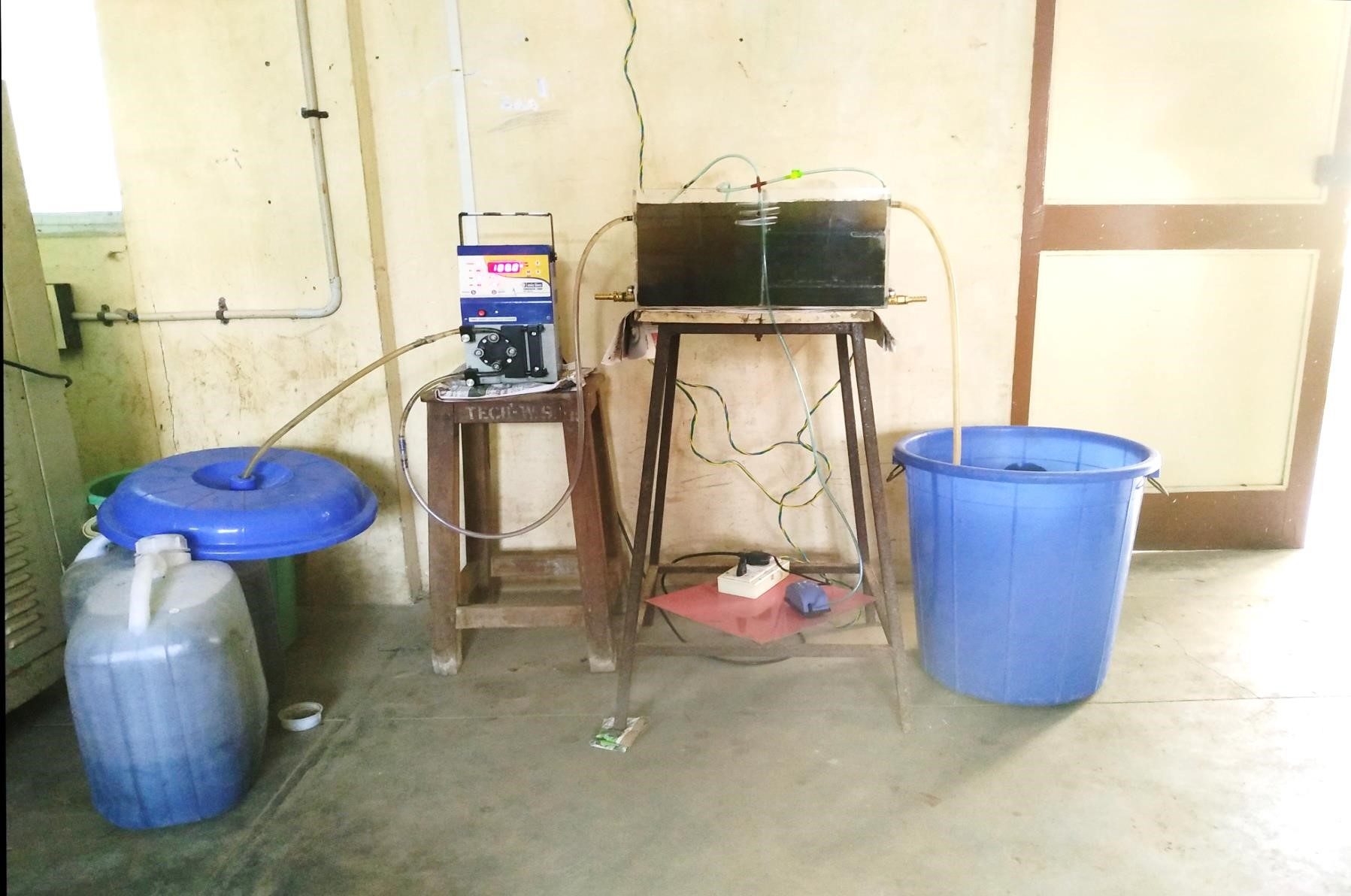Treatment of Dairy Wastewater using Aerobic Bio-Reactor
Main Article Content
Abstract
The Performance of an Aerobic Bio-Reactor (ABR) for the behavior of synthetic dairy processing wastewater was investigated. The system with 13.3 liters of working volume was accomplished by attached as well as suspended growth process as a novelty of this research work. The experimental analysis was carried out with the influent Chemical Oxygen Demand of synthetic dairy wastewater of 2920 mg/l, 3488 mg/l and 4000 mg/l at Hydraulic Retention Times (HRT) of 11, 14, 17, 21, 28, 42, 84 and 141 hours. During the experiment, pH plays an important role and the MLSS was maintained within the permissible limit continuously. In an AHBR, the maximum COD removal efficiency was attained 93.15% with an Organic Loading Rate (OLR) of 2.489 kg COD/m3.day.
Article Details
References
Abdulgader M, Yu QJ, Zinatizadeh A, Williams P (2004). Biological treatment of milk processing wastewater in a sequencing batch flexible fibre biofilm reactor. Asia-Pac J Chem Eng. 4:698–703.
Abdulrazak A (2007) Dairy industry effluent treatment: anaerobic treatment of whey in stirred batch reactor. Scribd.
B. Shete, N.P. Shinkar, Dairy industry wastewater sources, characteristics & its effects on environment, Int. J. Curr. Eng. Technol., 3 (2013) 1611–1615.
Bandpi AM, Bazari H (2004) Biological treatment of dairy wastewater by sequencing batch reactor. Iranian J Env Health Sci Eng. 1: 65-69.
Banik GC, Dague RR (1997) ASBR treatment of low strength industrial wastewater at psychrophilic temperatures. Water Science and Technology's 36: 337-344.
Calli B, Yukselen MA (2002) Anaerobic treatment by a hybrid reactor Environ Eng. Sci. 19: 143-150.
Demirel B, Yenigun O, Onay TT (2005) Anaerobic treatment of dairy wastewaters: a review. Process Biochemistry 40: 2583-2595.
Dugba P, Zhang R (1999) Treatment of dairy wastewater with twostage anaerobic sequencing batch reactor systems: thermophilic versus mesophilic operations. Bioresour Technol. 68: 225-233.
G. Janet Joshiba, P. Senthil Kumar, Carolin C. Femina, Eunice Jayashree, R. Racchana, S. Sivanesan 2019. Critical review on biological treatment strategies of dairy wastewater, Desalination and Water Treatment. 160, 94-109.
Gavala N, Kopsinis H, Skiadas IV, Stamatelatou K, Lyberatos G (1999) Treatment of dairy wastewater using an upflow anaerobic sludge blanket reactor. J Agri Eng Res. 73: 59-63.
Gopinathan M, Thirumurthy M (2012) Feasibility Studies on Static Pile Co Composting of Organic Fraction of Municipal Solid Waste With Dairy Waste Water. En Res Eng Manag. 2: 34-39.
Kavitha RV, Kumar S, Suresh R, Krishnamurthy V (2013) Performance evaluation and biological treatment of dairy waste water treatment plant by upflow anaerobic sludge blanket reactor. Int J Chem Petrochem Technol. 3: 9-20.
Koshta V (2010) Study on performance evaluation for anaerobic fixed film reactor for treatment of dairy effluent using commercial packing media. M.Tech Thesis. Anand Agricultural University, Anand pp: 96-99.
Loo KV, Liao PH (1990) Treatment of poultry processing wastewater using sequencing batch reactors. Canadian Agriculture Eng. 32: 299-305.
Lyliam Loperena, Mario Daniel Ferrari, Veronica Saravia, Daiman Murro, Cynthia Lima, Lucia Ferrando, Ana Fernandez, Claudia Lareo (2007). Performance of a commercial inoculum for the aerobic biodegradation of a high fat content dairy wastewater, Bioresource Technology. 98, 1045–1051.
Mahvi AH (2008) Sequential batch reactor: A promising technology in waste water treatment. Iranian J En Health Sci Eng. 5: 79-90.
N. Schwarzenbeck, J.M Borges, P. Wilderer, Treatment of dairy effluents in an aerobic granular sludge sequencing batch reac¬tor, Appl. Microbiol. Biotechnol., 66 (2005) 711–718.
Nadais H, Capela I, Arroja L, Duarte A (2005) Optimum cycle time for intermittent UASB reactors treating dairy wastewater. Water Res. 39:1511-1518.
Neczaj E, Kacprzak M, Kamizela T, Lach J, Okoniewska E (2008) Sequencing batch reactor system for the co-treatment of landfill leachate and dairy wastewater. Desalination 222: 404-409.
P. Birwal, G.D. Prinyanka, S.P. Saurabh, Advanced technolo¬gies for dairy effluent treatment, J. Food. Nutr. Popul. Health, 1 (2017) 3–7.
P.J. Samkutty, R.H. Gough, P. McGrew, Biological treatment of dairy plant wastewater, J. Environ. Sci. Heal. Part A Environ. Sci. Eng. Toxicol., 31 (1996) 2143–2153.
Sengil A, Ozacar M (2006) Treatment of dairy wastewaters by electrocoagulation using mild steel electrodes. J Hazard Mat. 137: 1197-1205.
Sharma P (2008) Performance evaluation of wastewater treatment plant for milk based food industry. M.Tech. Thesis Department of Biotechnology & Environmental Sciences, Thapar University, Patiala-147004 (India) pp: 34-37.
Tilche, A., Bortone,G.,Forner, G.,Indulti,M., Stante,L.,and Tesini, O. (1994). Combination of anaerobic digestion and dienitrification in a hybrid upflow anaerobic filter integrated in a nutrient removal treatment plant. In Water Science and Technology. 30(12), 405.
Usack, J.G., Spirito,C.M.,and Angenent, L.T. (2012). Continuously-stirred anaerobic digester to convert organic wastes into biogas: system setup and basic operation. Journal of Visualized Experiments. (65), e3978.
Vidal, G., Videla,S. and Diez,M.C. (2001). Molecular weight distribution of pinus radiata Kraft mill wastewater treated by anaerobic digestion. Bioresource Technology. 77(2), 183-191.
Vlyssides, A.G., Tsimas,E.S.,Barampouti,E.M.P.,and Mai,S.T. (2012). Anaerobic digestion of cheese dairy wastewater following chemical oxidation. Biosystems Engineering. 113(3), 253-258.
World B (1998) Pollution prevention and abatement: Dairy industry. Draft technical background document. Environment Department, Washington, D.C. pp: 11-14.
Wu, P., Ji, X.M.,Song,X.K.,and Shen, Y.L. (2013). Nutrient removal performance and microbial community analysis of a combined ABR-MBR (CAMBR) process. Chemical Engineering Journal. 232, 273-279.

